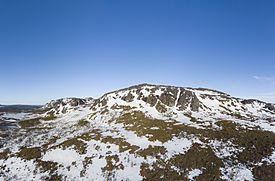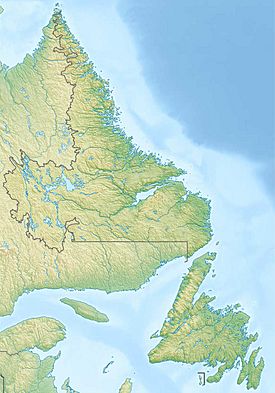Annieopsquotch Mountains facts for kids
Quick facts for kids Annieopsquotch Mountains |
|
|---|---|

Annieopsquotch Mountains near Burgeo, NL
|
|
| Highest point | |
| Elevation | 687 m (2,254 ft) |
| Naming | |
| Etymology | Mi'kmaq for terrible rocks |
| Geography | |
| Country | Canada |
| Province | Newfoundland and Labrador |
| Range coordinates | 48°21′N 57°30′W / 48.350°N 57.500°W |
| Parent range | Appalachian Mountains |
The Annieopsquotch Mountains (pronounced AN-ee-OP-skwotch) are a range of hills in Newfoundland, Canada. They are found in the southwestern part of the island. These mountains are located east of Bay St. George.
The highest point of the Annieopsquotch Mountains is about 687 meters (2,254 feet) above sea level. This range stretches in a northeast direction. It lies between Victoria Lake and Red Indian Lake. The name "Annieopsquotch" comes from the Mi'kmaq language. It means 'terrible rocks'.
About the Annieopsquotch Mountains
These mountains are part of the larger Appalachian Mountains system. The Appalachians are a very old mountain range. They stretch along the eastern side of North America. The Annieopsquotch Mountains are a smaller part of this huge system.
What are they made of?
The rocks in the Annieopsquotch Mountains are very old. They formed during a time called the Ordovician period. This was about 485 to 443 million years ago. These rocks were once part of the ocean floor.
Over millions of years, the Earth's plates moved. This caused the ancient Iapetus Ocean to close. As it closed, parts of the ocean floor were pushed up. They were forced onto the land. This process created the mountains we see today.
Later, during the Silurian period (about 443 to 419 million years ago), new rocks formed. These were sedimentary rocks. They settled on top of the older ocean floor rocks. Even later, in the Devonian period (about 419 to 359 million years ago), hot, melted rock called granite pushed into the area.
The land continued to change through the Carboniferous period. This was about 359 to 299 million years ago. The rocks kept moving and tilting. This long history of change shaped the Annieopsquotch Mountains.


